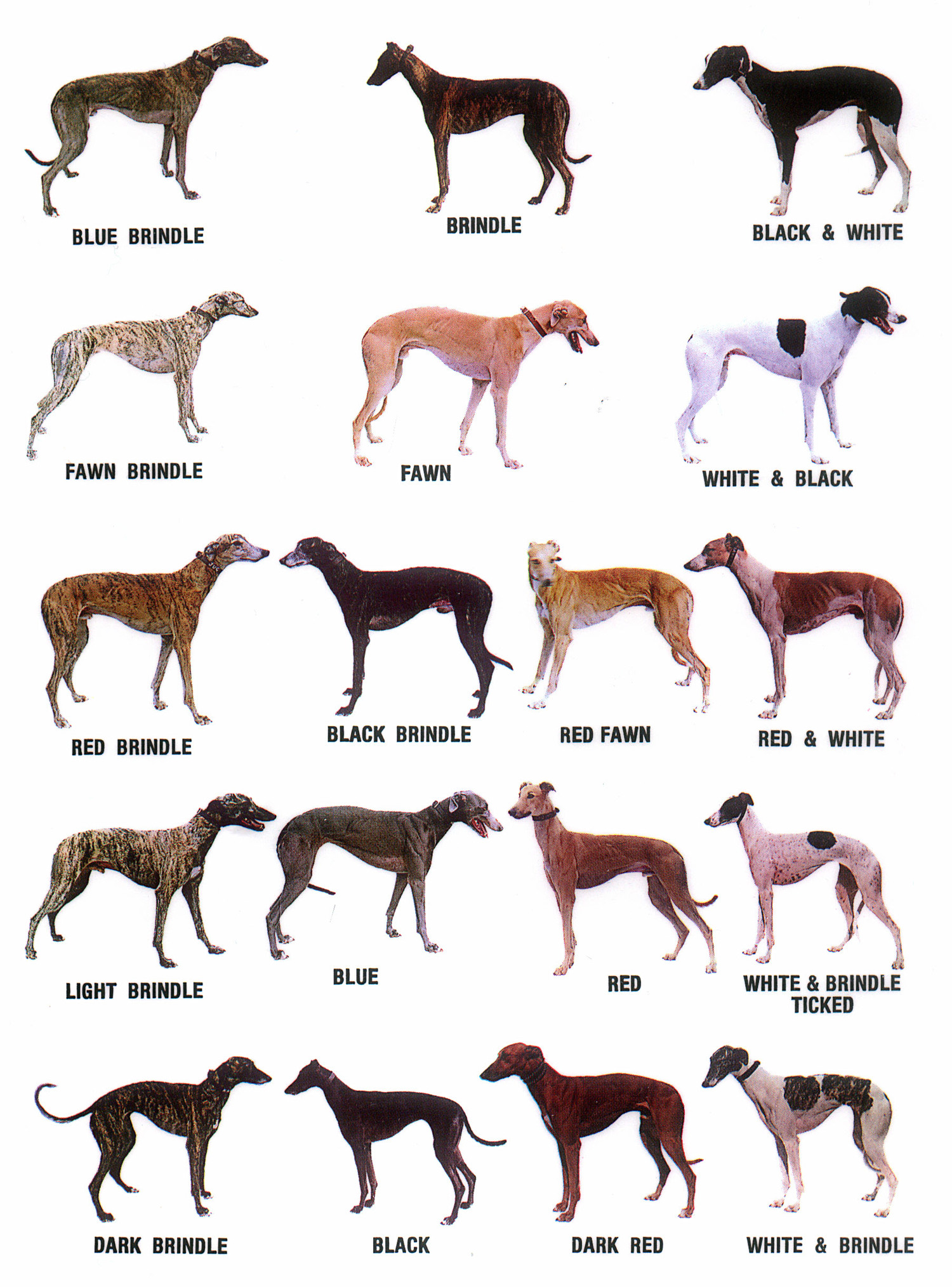About Greyhounds
Greyhounds are friendly, affectionate dogs who thrive on human companionship and usually adapt very quickly and remarkably well to retirement. They come in all colors, with activity levels from active to sedate. Contrary to popular belief, they do not require large amounts of exercise. A daily walk and good diet are sufficient.
We try to answer the most common questions about greyhounds below. We also recommend that you check out our suggested reading page for excellent references on greyhounds.
What is the life expectancy of a greyhound?
Greyhounds are generally healthy and as a rule are not predisposed to some of the problems such as hip dysplasia that other large-breed dogs are known for. The life expectancy of the average healthy greyhound is 12-14 years, although many do live even longer.
Do greyhounds shed?
Yes, but very little compared to most breeds. They are low dander and many people with allergies find themselves able to tolerate this breed. They do not require constant bathing or daily grooming.
did i hear greyhounds can come in 18 different colors?
Greyhounds come in a variety of colors. In fact, the American Greyhound Track Operators Association officially recognizes 18 colors for greyhounds. However, the fact of the matter is that there are even more colors than the 18 seen below.
How are greyhounds with children?
Greyhounds are very loving with their human companions, but they also have a highly-developed sense of personal space, and children must be taught to respect that. Greyhounds can be startled by the innocent actions of children. Therefore, you should take care in introducing a greyhound to a home with small children. That being said, the overwhelming majority of greyhounds do great with children.
How are they with other pets?
Greyhounds are very social with other greyhounds, but it must be remembered that they have not encountered other breeds of dogs. As such, they must be introduced to other animals, particularly small animals such as cats and little dogs, very carefully.
How much do greyhounds eat?
Greyhounds typically eat between two and four cups a day, depending on their normal weight. They should not exercise thirty minutes before eating or one hour after they eat.
How much exercise do they need?
Contrary to popular opinion, greyhounds are not hyperactive animals. Keep in mind that a greyhound race is a sprint, not a long-distance endeavor, and that greyhounds sleep a lot between races. Greyhounds like to run, but they don’t need to run. Most are quite happy with several walks per day to relieve themselves, with one longer walk for exercise if you don’t happen to have a fenced yard.
What about fences?
Because of their great adaptability, greyhounds do well in modest size apartments, townhouses, and homes. A fenced yard or patio area ensures your greyhound’s safety. Although fences are not mandatory, they are very useful, especially on cold winter nights.
NOTE: Electronic fencing is not suitable for use with greyhounds. A greyhound in hot pursuit of a small animal will run right through an electronic fence, completely ignoring the shock. Electronic fences also do not keep out stray dogs, stray cats or wildlife. Electronic fences are useless when the power is out, unless there is a backup power source in place.
Do greyhounds make good watchdogs?
As a rule, greyhounds don’t make good guard dogs. They can be intimidating because of their size, but they are not aggressive toward people and therefore do not make good guard dogs.
Are greyhounds house-broken?
They are kennel-trained. That means they are trained not to relieve themselves in their “house.” It is important that you spend time with your dog the first few days so that they understand that “outside” is where they go to relieve themselves. They are intelligent dogs and are eager to please, so get them into a routine as soon as possible.
Why do greyhounds have to be kept on a leash if they aren't in a fenced area?
Greyhounds are sighthounds; they can see the movement of a squirrel up to half a mile away. Since they are the second-fastest land mammal (second only to the Cheetah) and are capable of reaching speeds of up to 45 mph within three strides, an off-leash greyhound who sees movement in the distance and decides to chase it will be in the next county before you can say “Come back!” Greyhounds do not know to fear roads and cars, and will run out in traffic at full speed with no thought of personal danger. It is absolutely crucial to keep your greyhound on a leash at all times if not in an enclosed area.
How well do greyhounds walk on a leash?
Greyhounds are trained by their handler at the track to walk on a leash. Like all dogs, they benefit from reward-based training.
NOTE: Here are just a few reasons why you should NEVER use a flexi-lead with your greyhound.
A greyhound can reach his top speed before the length of a flexi-lead plays out, resulting in a choked dog when the end of the lead is reached, or, more often, a dropped lead. This is also why you must never tether a greyhound to any object.
It's very easy to drop the hard plastic handle and the loud noise of the handle hitting the ground can spook your hound. The spooked hound then bolts and the noisy handle follows, making even more noise.
Flexi-leads give your dog too much freedom - it allows your dog to get far in front of you, where you are totally out of control of your hound.
Some flexi-leads cords are difficult to see, which can cause accidents with passers-by.
What equipment do I need to buy that the adoption fee does not cover?
Your greyhound will need a coat for use in cold weather. Since greyhounds have very little body fat, they are unable to keep themselves warm in cold weather. We can provide you a coat for a nominal fee.
You will also need to care for your hound’s teeth, so you will need a toothbrush and flavored toothpaste for dogs.
To keep your hound’s nails trimmed, you will need either a guillotine nail clipper or a Dremel tool. If you don’t care to trim your hound’s nails yourself, most vets and pet stores with grooming salons will do this for a nominal charge.
Why do I need to use a “grey-savvy” veterinarian?
There are many facets of the medical care of greyhounds that are different from those of other breeds. Greyhounds are particularly sensitive to anesthesia, they have different thyroid panel measurements, etc. It is important to be sure that your veterinarian is experienced in treating greyhounds. We can provide a list of suggested vets in your area if your current vet is not familiar with greyhounds or if you are a new pet owner and do not yet have an established relationship with a vet.
A Word of Caution
Greyhounds should never be walked without a leash. They do not understand the dangers of traffic and they cannot be caught when running at full speed. Secondly, they do not tolerate heat or cold very well. Cool-down jackets will avoid heat stroke; for the winter months, a warm fleece coat is essential. Greyhounds should never be tied outside. They will react to anything that attracts their curiosity and could therefore get seriously injured.
A Final Note
Ownership of a pet is a full-time job. You must be willing to make compromises – if you are expecting the greyhound to “fit into your lifestyle,” you are setting yourself up for failure. The most important thing for you to do is to take charge and be the one in control. Even a shy dog will adjust more readily if it is taught basic rules, but all it may require is a change in tone of voice. A more dominant dog may require more vigorous control techniques. That means being firm and consistent and giving lots of positive reinforcement and the best reward of all – your love!


